Report on Self-Driving Cars: Future Scope and Analysis
VerifiedAdded on 2021/12/16
|9
|1953
|154
Report
AI Summary
This report provides a comprehensive overview of self-driving cars, also known as autonomous or driverless vehicles. It begins with an introduction that defines self-driving cars and their operational capabilities. The discussion section delves into the advantages, such as enhanced safety, reduced labor costs, and increased roadway capacity. It also addresses potential disadvantages, including job losses, privacy concerns, and the risk of hacking. The report further explores the future scope of automated cars, including automation and ride-sharing, as well as the development of new vehicles for new cities. The report concludes by summarizing the key points and highlighting the transformative potential of self-driving technology. The report also includes a list of relevant references to support the discussed information.

Running head: SELF DRIVING CARS
SELF DRIVING CARS
Name of student:
Name of university:
Author’s note:
SELF DRIVING CARS
Name of student:
Name of university:
Author’s note:
Paraphrase This Document
Need a fresh take? Get an instant paraphrase of this document with our AI Paraphraser

1SELF DRIVING CARS
Table of Contents
Introduction....................................................................................................................2
Discussion......................................................................................................................2
Advantages of self-driving cars.................................................................................2
Potential disadvantages of self-driving cars...............................................................4
Future scope of automated cars..................................................................................4
Conclusion......................................................................................................................6
References......................................................................................................................7
Table of Contents
Introduction....................................................................................................................2
Discussion......................................................................................................................2
Advantages of self-driving cars.................................................................................2
Potential disadvantages of self-driving cars...............................................................4
Future scope of automated cars..................................................................................4
Conclusion......................................................................................................................6
References......................................................................................................................7
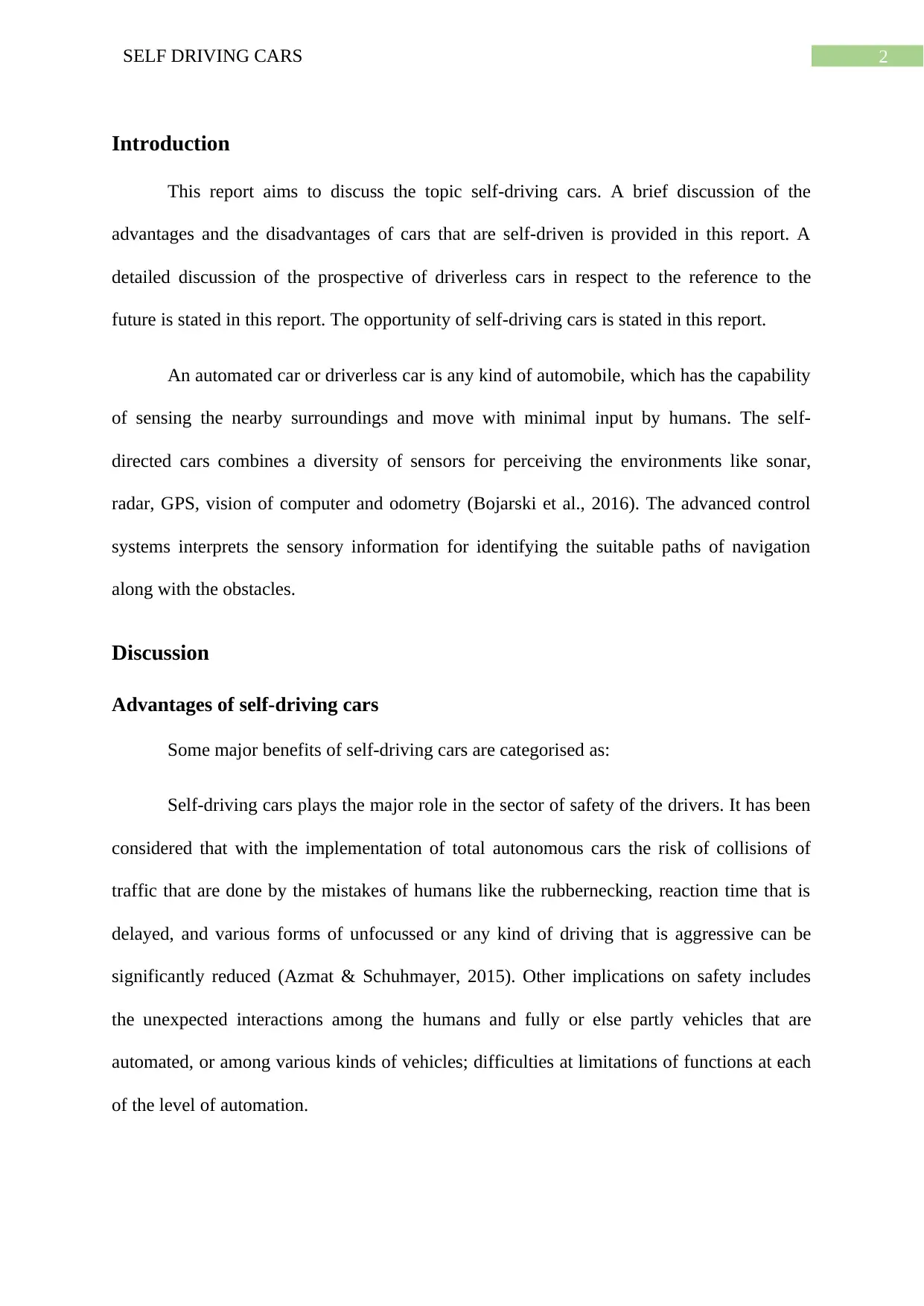
2SELF DRIVING CARS
Introduction
This report aims to discuss the topic self-driving cars. A brief discussion of the
advantages and the disadvantages of cars that are self-driven is provided in this report. A
detailed discussion of the prospective of driverless cars in respect to the reference to the
future is stated in this report. The opportunity of self-driving cars is stated in this report.
An automated car or driverless car is any kind of automobile, which has the capability
of sensing the nearby surroundings and move with minimal input by humans. The self-
directed cars combines a diversity of sensors for perceiving the environments like sonar,
radar, GPS, vision of computer and odometry (Bojarski et al., 2016). The advanced control
systems interprets the sensory information for identifying the suitable paths of navigation
along with the obstacles.
Discussion
Advantages of self-driving cars
Some major benefits of self-driving cars are categorised as:
Self-driving cars plays the major role in the sector of safety of the drivers. It has been
considered that with the implementation of total autonomous cars the risk of collisions of
traffic that are done by the mistakes of humans like the rubbernecking, reaction time that is
delayed, and various forms of unfocussed or any kind of driving that is aggressive can be
significantly reduced (Azmat & Schuhmayer, 2015). Other implications on safety includes
the unexpected interactions among the humans and fully or else partly vehicles that are
automated, or among various kinds of vehicles; difficulties at limitations of functions at each
of the level of automation.
Introduction
This report aims to discuss the topic self-driving cars. A brief discussion of the
advantages and the disadvantages of cars that are self-driven is provided in this report. A
detailed discussion of the prospective of driverless cars in respect to the reference to the
future is stated in this report. The opportunity of self-driving cars is stated in this report.
An automated car or driverless car is any kind of automobile, which has the capability
of sensing the nearby surroundings and move with minimal input by humans. The self-
directed cars combines a diversity of sensors for perceiving the environments like sonar,
radar, GPS, vision of computer and odometry (Bojarski et al., 2016). The advanced control
systems interprets the sensory information for identifying the suitable paths of navigation
along with the obstacles.
Discussion
Advantages of self-driving cars
Some major benefits of self-driving cars are categorised as:
Self-driving cars plays the major role in the sector of safety of the drivers. It has been
considered that with the implementation of total autonomous cars the risk of collisions of
traffic that are done by the mistakes of humans like the rubbernecking, reaction time that is
delayed, and various forms of unfocussed or any kind of driving that is aggressive can be
significantly reduced (Azmat & Schuhmayer, 2015). Other implications on safety includes
the unexpected interactions among the humans and fully or else partly vehicles that are
automated, or among various kinds of vehicles; difficulties at limitations of functions at each
of the level of automation.
⊘ This is a preview!⊘
Do you want full access?
Subscribe today to unlock all pages.

Trusted by 1+ million students worldwide
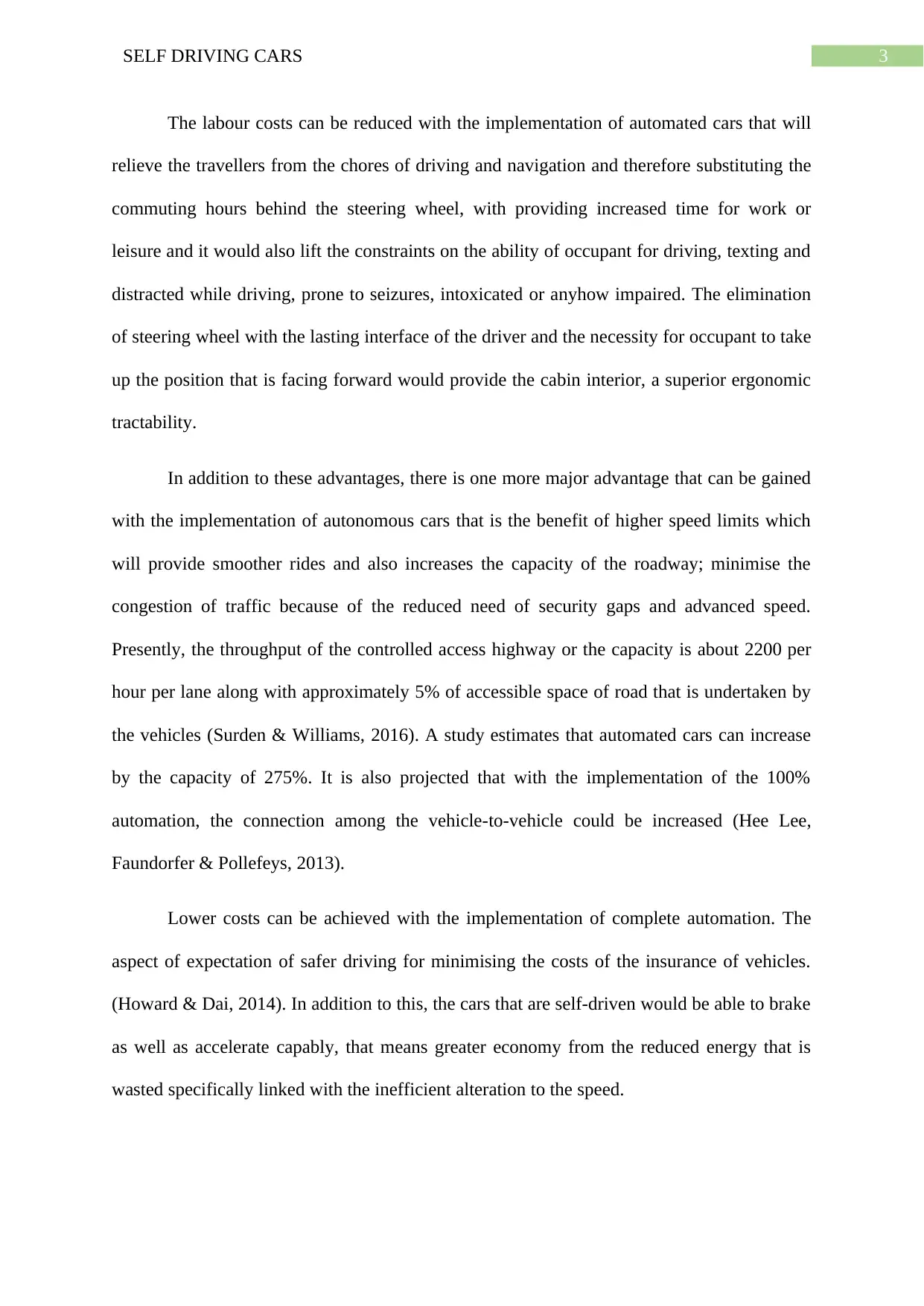
3SELF DRIVING CARS
The labour costs can be reduced with the implementation of automated cars that will
relieve the travellers from the chores of driving and navigation and therefore substituting the
commuting hours behind the steering wheel, with providing increased time for work or
leisure and it would also lift the constraints on the ability of occupant for driving, texting and
distracted while driving, prone to seizures, intoxicated or anyhow impaired. The elimination
of steering wheel with the lasting interface of the driver and the necessity for occupant to take
up the position that is facing forward would provide the cabin interior, a superior ergonomic
tractability.
In addition to these advantages, there is one more major advantage that can be gained
with the implementation of autonomous cars that is the benefit of higher speed limits which
will provide smoother rides and also increases the capacity of the roadway; minimise the
congestion of traffic because of the reduced need of security gaps and advanced speed.
Presently, the throughput of the controlled access highway or the capacity is about 2200 per
hour per lane along with approximately 5% of accessible space of road that is undertaken by
the vehicles (Surden & Williams, 2016). A study estimates that automated cars can increase
by the capacity of 275%. It is also projected that with the implementation of the 100%
automation, the connection among the vehicle-to-vehicle could be increased (Hee Lee,
Faundorfer & Pollefeys, 2013).
Lower costs can be achieved with the implementation of complete automation. The
aspect of expectation of safer driving for minimising the costs of the insurance of vehicles.
(Howard & Dai, 2014). In addition to this, the cars that are self-driven would be able to brake
as well as accelerate capably, that means greater economy from the reduced energy that is
wasted specifically linked with the inefficient alteration to the speed.
The labour costs can be reduced with the implementation of automated cars that will
relieve the travellers from the chores of driving and navigation and therefore substituting the
commuting hours behind the steering wheel, with providing increased time for work or
leisure and it would also lift the constraints on the ability of occupant for driving, texting and
distracted while driving, prone to seizures, intoxicated or anyhow impaired. The elimination
of steering wheel with the lasting interface of the driver and the necessity for occupant to take
up the position that is facing forward would provide the cabin interior, a superior ergonomic
tractability.
In addition to these advantages, there is one more major advantage that can be gained
with the implementation of autonomous cars that is the benefit of higher speed limits which
will provide smoother rides and also increases the capacity of the roadway; minimise the
congestion of traffic because of the reduced need of security gaps and advanced speed.
Presently, the throughput of the controlled access highway or the capacity is about 2200 per
hour per lane along with approximately 5% of accessible space of road that is undertaken by
the vehicles (Surden & Williams, 2016). A study estimates that automated cars can increase
by the capacity of 275%. It is also projected that with the implementation of the 100%
automation, the connection among the vehicle-to-vehicle could be increased (Hee Lee,
Faundorfer & Pollefeys, 2013).
Lower costs can be achieved with the implementation of complete automation. The
aspect of expectation of safer driving for minimising the costs of the insurance of vehicles.
(Howard & Dai, 2014). In addition to this, the cars that are self-driven would be able to brake
as well as accelerate capably, that means greater economy from the reduced energy that is
wasted specifically linked with the inefficient alteration to the speed.
Paraphrase This Document
Need a fresh take? Get an instant paraphrase of this document with our AI Paraphraser
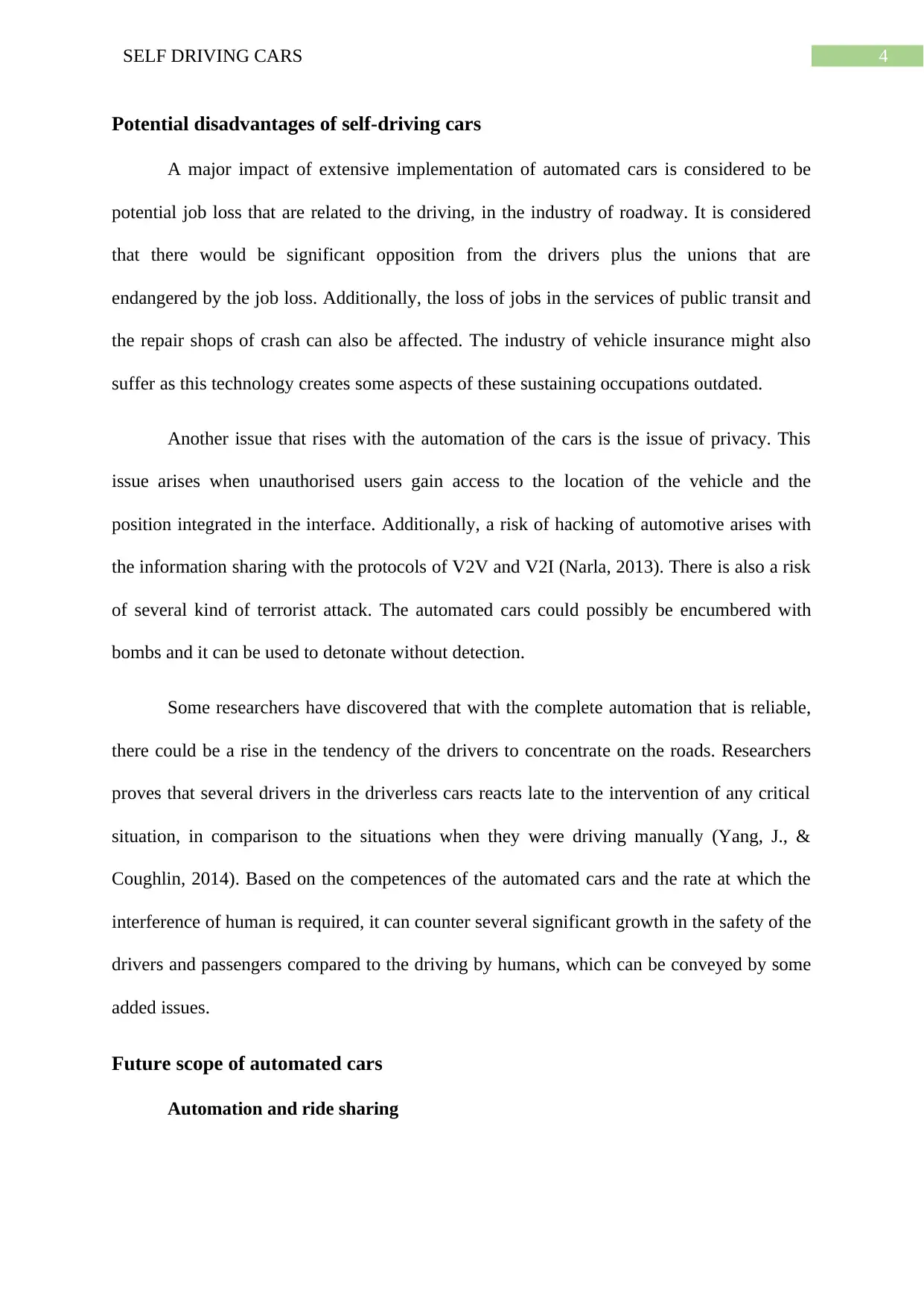
4SELF DRIVING CARS
Potential disadvantages of self-driving cars
A major impact of extensive implementation of automated cars is considered to be
potential job loss that are related to the driving, in the industry of roadway. It is considered
that there would be significant opposition from the drivers plus the unions that are
endangered by the job loss. Additionally, the loss of jobs in the services of public transit and
the repair shops of crash can also be affected. The industry of vehicle insurance might also
suffer as this technology creates some aspects of these sustaining occupations outdated.
Another issue that rises with the automation of the cars is the issue of privacy. This
issue arises when unauthorised users gain access to the location of the vehicle and the
position integrated in the interface. Additionally, a risk of hacking of automotive arises with
the information sharing with the protocols of V2V and V2I (Narla, 2013). There is also a risk
of several kind of terrorist attack. The automated cars could possibly be encumbered with
bombs and it can be used to detonate without detection.
Some researchers have discovered that with the complete automation that is reliable,
there could be a rise in the tendency of the drivers to concentrate on the roads. Researchers
proves that several drivers in the driverless cars reacts late to the intervention of any critical
situation, in comparison to the situations when they were driving manually (Yang, J., &
Coughlin, 2014). Based on the competences of the automated cars and the rate at which the
interference of human is required, it can counter several significant growth in the safety of the
drivers and passengers compared to the driving by humans, which can be conveyed by some
added issues.
Future scope of automated cars
Automation and ride sharing
Potential disadvantages of self-driving cars
A major impact of extensive implementation of automated cars is considered to be
potential job loss that are related to the driving, in the industry of roadway. It is considered
that there would be significant opposition from the drivers plus the unions that are
endangered by the job loss. Additionally, the loss of jobs in the services of public transit and
the repair shops of crash can also be affected. The industry of vehicle insurance might also
suffer as this technology creates some aspects of these sustaining occupations outdated.
Another issue that rises with the automation of the cars is the issue of privacy. This
issue arises when unauthorised users gain access to the location of the vehicle and the
position integrated in the interface. Additionally, a risk of hacking of automotive arises with
the information sharing with the protocols of V2V and V2I (Narla, 2013). There is also a risk
of several kind of terrorist attack. The automated cars could possibly be encumbered with
bombs and it can be used to detonate without detection.
Some researchers have discovered that with the complete automation that is reliable,
there could be a rise in the tendency of the drivers to concentrate on the roads. Researchers
proves that several drivers in the driverless cars reacts late to the intervention of any critical
situation, in comparison to the situations when they were driving manually (Yang, J., &
Coughlin, 2014). Based on the competences of the automated cars and the rate at which the
interference of human is required, it can counter several significant growth in the safety of the
drivers and passengers compared to the driving by humans, which can be conveyed by some
added issues.
Future scope of automated cars
Automation and ride sharing
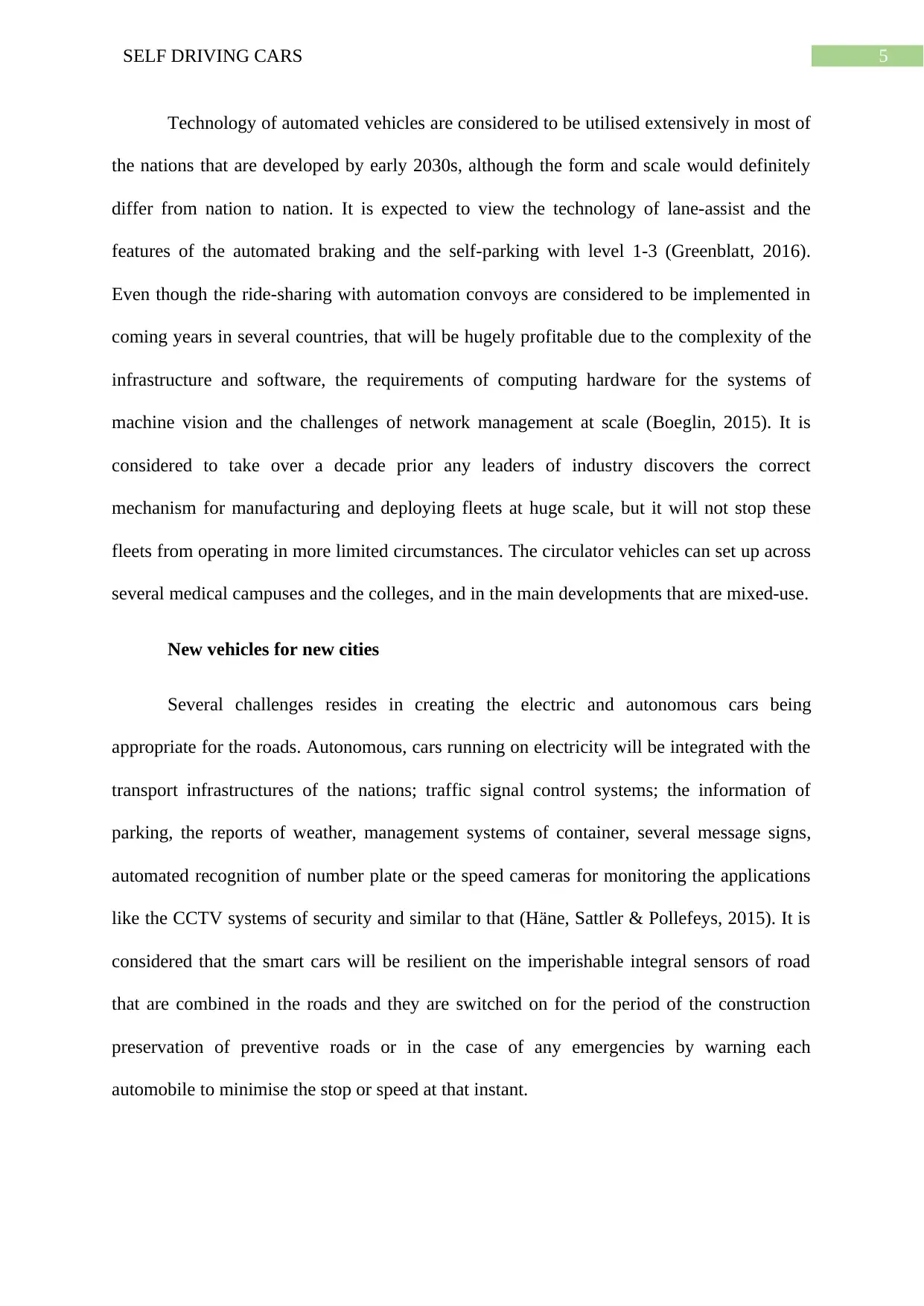
5SELF DRIVING CARS
Technology of automated vehicles are considered to be utilised extensively in most of
the nations that are developed by early 2030s, although the form and scale would definitely
differ from nation to nation. It is expected to view the technology of lane-assist and the
features of the automated braking and the self-parking with level 1-3 (Greenblatt, 2016).
Even though the ride-sharing with automation convoys are considered to be implemented in
coming years in several countries, that will be hugely profitable due to the complexity of the
infrastructure and software, the requirements of computing hardware for the systems of
machine vision and the challenges of network management at scale (Boeglin, 2015). It is
considered to take over a decade prior any leaders of industry discovers the correct
mechanism for manufacturing and deploying fleets at huge scale, but it will not stop these
fleets from operating in more limited circumstances. The circulator vehicles can set up across
several medical campuses and the colleges, and in the main developments that are mixed-use.
New vehicles for new cities
Several challenges resides in creating the electric and autonomous cars being
appropriate for the roads. Autonomous, cars running on electricity will be integrated with the
transport infrastructures of the nations; traffic signal control systems; the information of
parking, the reports of weather, management systems of container, several message signs,
automated recognition of number plate or the speed cameras for monitoring the applications
like the CCTV systems of security and similar to that (Häne, Sattler & Pollefeys, 2015). It is
considered that the smart cars will be resilient on the imperishable integral sensors of road
that are combined in the roads and they are switched on for the period of the construction
preservation of preventive roads or in the case of any emergencies by warning each
automobile to minimise the stop or speed at that instant.
Technology of automated vehicles are considered to be utilised extensively in most of
the nations that are developed by early 2030s, although the form and scale would definitely
differ from nation to nation. It is expected to view the technology of lane-assist and the
features of the automated braking and the self-parking with level 1-3 (Greenblatt, 2016).
Even though the ride-sharing with automation convoys are considered to be implemented in
coming years in several countries, that will be hugely profitable due to the complexity of the
infrastructure and software, the requirements of computing hardware for the systems of
machine vision and the challenges of network management at scale (Boeglin, 2015). It is
considered to take over a decade prior any leaders of industry discovers the correct
mechanism for manufacturing and deploying fleets at huge scale, but it will not stop these
fleets from operating in more limited circumstances. The circulator vehicles can set up across
several medical campuses and the colleges, and in the main developments that are mixed-use.
New vehicles for new cities
Several challenges resides in creating the electric and autonomous cars being
appropriate for the roads. Autonomous, cars running on electricity will be integrated with the
transport infrastructures of the nations; traffic signal control systems; the information of
parking, the reports of weather, management systems of container, several message signs,
automated recognition of number plate or the speed cameras for monitoring the applications
like the CCTV systems of security and similar to that (Häne, Sattler & Pollefeys, 2015). It is
considered that the smart cars will be resilient on the imperishable integral sensors of road
that are combined in the roads and they are switched on for the period of the construction
preservation of preventive roads or in the case of any emergencies by warning each
automobile to minimise the stop or speed at that instant.
⊘ This is a preview!⊘
Do you want full access?
Subscribe today to unlock all pages.

Trusted by 1+ million students worldwide
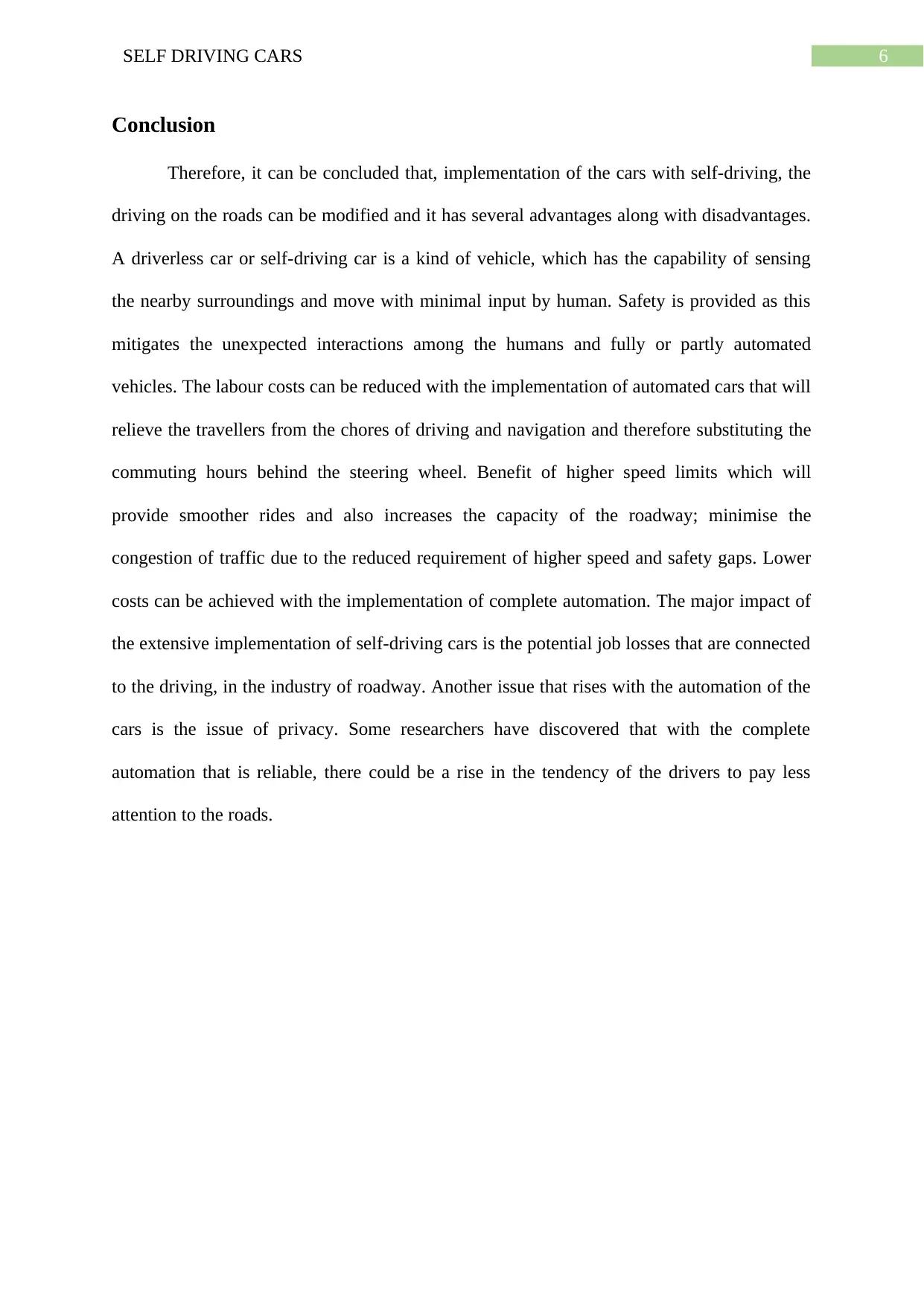
6SELF DRIVING CARS
Conclusion
Therefore, it can be concluded that, implementation of the cars with self-driving, the
driving on the roads can be modified and it has several advantages along with disadvantages.
A driverless car or self-driving car is a kind of vehicle, which has the capability of sensing
the nearby surroundings and move with minimal input by human. Safety is provided as this
mitigates the unexpected interactions among the humans and fully or partly automated
vehicles. The labour costs can be reduced with the implementation of automated cars that will
relieve the travellers from the chores of driving and navigation and therefore substituting the
commuting hours behind the steering wheel. Benefit of higher speed limits which will
provide smoother rides and also increases the capacity of the roadway; minimise the
congestion of traffic due to the reduced requirement of higher speed and safety gaps. Lower
costs can be achieved with the implementation of complete automation. The major impact of
the extensive implementation of self-driving cars is the potential job losses that are connected
to the driving, in the industry of roadway. Another issue that rises with the automation of the
cars is the issue of privacy. Some researchers have discovered that with the complete
automation that is reliable, there could be a rise in the tendency of the drivers to pay less
attention to the roads.
Conclusion
Therefore, it can be concluded that, implementation of the cars with self-driving, the
driving on the roads can be modified and it has several advantages along with disadvantages.
A driverless car or self-driving car is a kind of vehicle, which has the capability of sensing
the nearby surroundings and move with minimal input by human. Safety is provided as this
mitigates the unexpected interactions among the humans and fully or partly automated
vehicles. The labour costs can be reduced with the implementation of automated cars that will
relieve the travellers from the chores of driving and navigation and therefore substituting the
commuting hours behind the steering wheel. Benefit of higher speed limits which will
provide smoother rides and also increases the capacity of the roadway; minimise the
congestion of traffic due to the reduced requirement of higher speed and safety gaps. Lower
costs can be achieved with the implementation of complete automation. The major impact of
the extensive implementation of self-driving cars is the potential job losses that are connected
to the driving, in the industry of roadway. Another issue that rises with the automation of the
cars is the issue of privacy. Some researchers have discovered that with the complete
automation that is reliable, there could be a rise in the tendency of the drivers to pay less
attention to the roads.
Paraphrase This Document
Need a fresh take? Get an instant paraphrase of this document with our AI Paraphraser
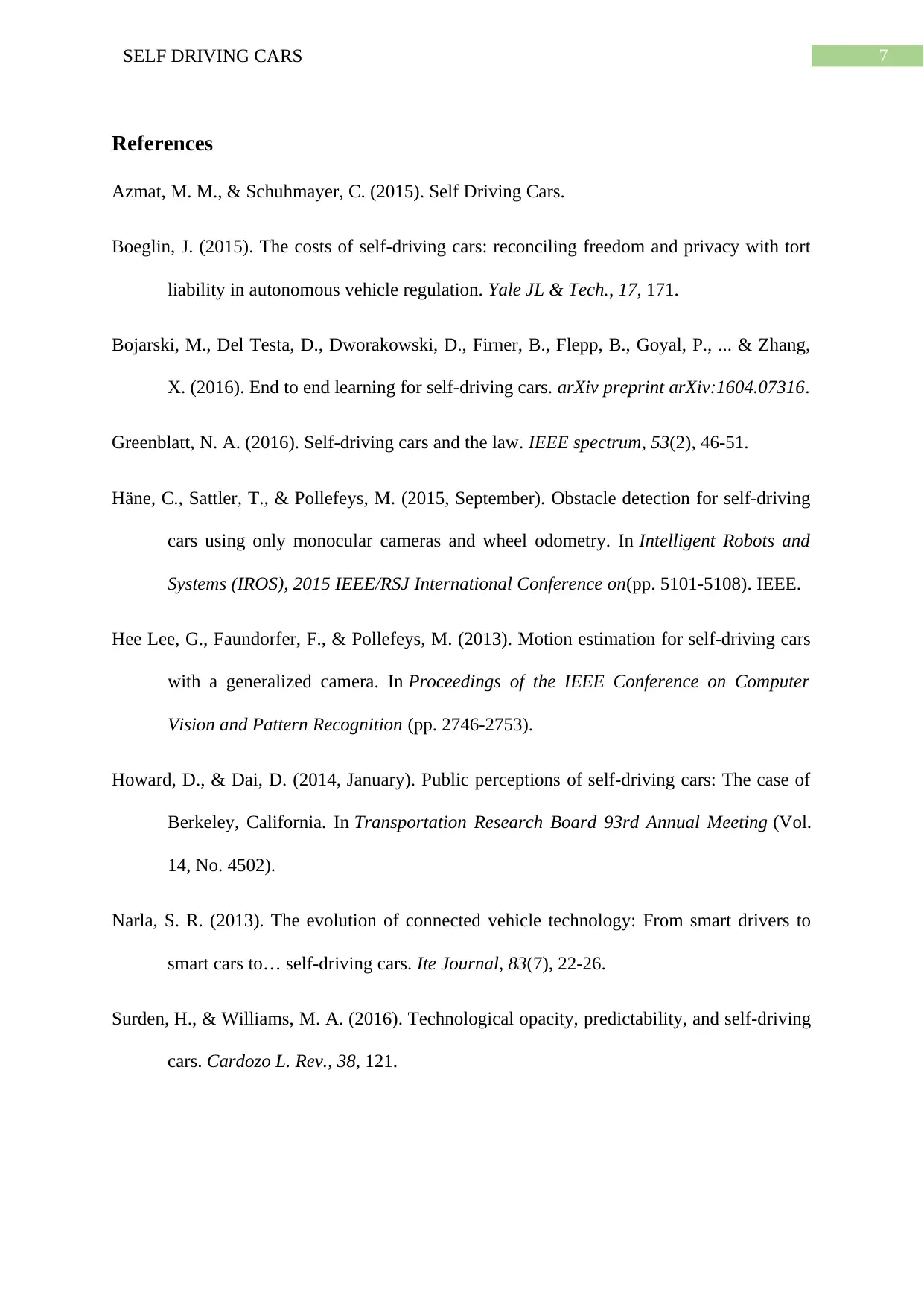
7SELF DRIVING CARS
References
Azmat, M. M., & Schuhmayer, C. (2015). Self Driving Cars.
Boeglin, J. (2015). The costs of self-driving cars: reconciling freedom and privacy with tort
liability in autonomous vehicle regulation. Yale JL & Tech., 17, 171.
Bojarski, M., Del Testa, D., Dworakowski, D., Firner, B., Flepp, B., Goyal, P., ... & Zhang,
X. (2016). End to end learning for self-driving cars. arXiv preprint arXiv:1604.07316.
Greenblatt, N. A. (2016). Self-driving cars and the law. IEEE spectrum, 53(2), 46-51.
Häne, C., Sattler, T., & Pollefeys, M. (2015, September). Obstacle detection for self-driving
cars using only monocular cameras and wheel odometry. In Intelligent Robots and
Systems (IROS), 2015 IEEE/RSJ International Conference on(pp. 5101-5108). IEEE.
Hee Lee, G., Faundorfer, F., & Pollefeys, M. (2013). Motion estimation for self-driving cars
with a generalized camera. In Proceedings of the IEEE Conference on Computer
Vision and Pattern Recognition (pp. 2746-2753).
Howard, D., & Dai, D. (2014, January). Public perceptions of self-driving cars: The case of
Berkeley, California. In Transportation Research Board 93rd Annual Meeting (Vol.
14, No. 4502).
Narla, S. R. (2013). The evolution of connected vehicle technology: From smart drivers to
smart cars to… self-driving cars. Ite Journal, 83(7), 22-26.
Surden, H., & Williams, M. A. (2016). Technological opacity, predictability, and self-driving
cars. Cardozo L. Rev., 38, 121.
References
Azmat, M. M., & Schuhmayer, C. (2015). Self Driving Cars.
Boeglin, J. (2015). The costs of self-driving cars: reconciling freedom and privacy with tort
liability in autonomous vehicle regulation. Yale JL & Tech., 17, 171.
Bojarski, M., Del Testa, D., Dworakowski, D., Firner, B., Flepp, B., Goyal, P., ... & Zhang,
X. (2016). End to end learning for self-driving cars. arXiv preprint arXiv:1604.07316.
Greenblatt, N. A. (2016). Self-driving cars and the law. IEEE spectrum, 53(2), 46-51.
Häne, C., Sattler, T., & Pollefeys, M. (2015, September). Obstacle detection for self-driving
cars using only monocular cameras and wheel odometry. In Intelligent Robots and
Systems (IROS), 2015 IEEE/RSJ International Conference on(pp. 5101-5108). IEEE.
Hee Lee, G., Faundorfer, F., & Pollefeys, M. (2013). Motion estimation for self-driving cars
with a generalized camera. In Proceedings of the IEEE Conference on Computer
Vision and Pattern Recognition (pp. 2746-2753).
Howard, D., & Dai, D. (2014, January). Public perceptions of self-driving cars: The case of
Berkeley, California. In Transportation Research Board 93rd Annual Meeting (Vol.
14, No. 4502).
Narla, S. R. (2013). The evolution of connected vehicle technology: From smart drivers to
smart cars to… self-driving cars. Ite Journal, 83(7), 22-26.
Surden, H., & Williams, M. A. (2016). Technological opacity, predictability, and self-driving
cars. Cardozo L. Rev., 38, 121.

8SELF DRIVING CARS
Yang, J., & Coughlin, J. F. (2014). In-vehicle technology for self-driving cars: Advantages
and challenges for aging drivers. International Journal of Automotive
Technology, 15(2), 333-340.
Yang, J., & Coughlin, J. F. (2014). In-vehicle technology for self-driving cars: Advantages
and challenges for aging drivers. International Journal of Automotive
Technology, 15(2), 333-340.
⊘ This is a preview!⊘
Do you want full access?
Subscribe today to unlock all pages.

Trusted by 1+ million students worldwide
1 out of 9
Related Documents
Your All-in-One AI-Powered Toolkit for Academic Success.
+13062052269
info@desklib.com
Available 24*7 on WhatsApp / Email
![[object Object]](/_next/static/media/star-bottom.7253800d.svg)
Unlock your academic potential
Copyright © 2020–2025 A2Z Services. All Rights Reserved. Developed and managed by ZUCOL.





